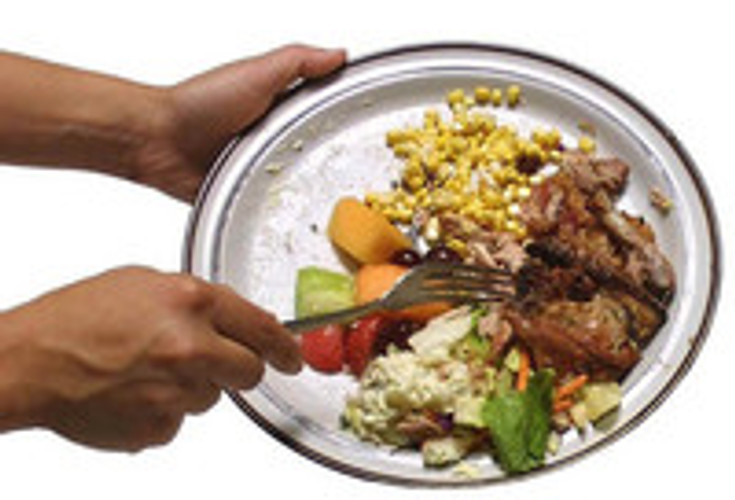Matt Anderson calls it a “napkano,” the volcano that erupts when guests at Zaxby’s leave a pile of wing-sauce-stained paper napkins—many barely used—on the table. “It’s a struggle,” says Anderson, systems development manager at the 673-unit Athens, Ga.-based chicken chain.
“We don’t want to anger people by denying them napkins,” he says, but waste is a concern.
And while a customer’s waste is harmful to profits, what’s happening in the kitchen can be just as harmful to the bottom line. According to a panel of speakers featured in the recent "U.S. Food Waste Challenge" webinar sponsored by the US Department of Agriculture, purchasing food that just ends up in a landfill has real costs for restaurants and the environment.
To combat the customer’s natural tendency to use more than they need in self- serve situations, restaurants are coming up with clever solutions.
At Matt Anderson’s Zaxby’s, the solution was to give customers a few napkins on their tray at the point of service. That way they can always ask for more but the overall paper costs have decreased. Culver’s has decided to make counter staff hand customers only the utensils they need for their order. Though it adds labor, the practice has proven to be not only cost-effective but less wasteful, the chain finds. “We don’t want self-serve dispensers for these items because of all the waste. It’s not only a loss of money, it’s bad for the landfill,” says Glenn Weiss, purchasing and facilities manager at Culver’s.
When the situation does call for self-serve equipment, several suppliers are unveiling portion-control dispensers beyond the standard straw, ketchup, and cup dispensers. The new Beverage Station from Server Products combines a thermoelectric cream or milk chiller with color-coded sweetener dispensers in a small footprint. It doles out preset portions of both dairy and sweeteners and eliminates paper packets, minimizing waste. Simpull Touch from US Foods dispenses one fork, spoon or knife at a time, deterring greedy guests and promoting sanitation. Its slim look is a plus for space- and style-conscious operations. Stuffing a lid dispenser can cause cup lids to stick together, but Vollrath’s LidSaver 2 prevents this with an added overload-protection feature. That means fewer lids are wasted or contaminated from excess handling, and the area around the dispenser remains tidier.
A study commissioned by the Food Waste Reduction Alliance found that approximately 80 billion pounds of food are discarded into US landfills every year, with restaurants accounting for 37 percent of that waste.
All of that waste accounts for a lot of lost profits. Reducing food waste can help restaurants improve their bottom line by identifying wasteful purchasing, identifying opportunities to sell waste for recycling, realizing tax benefits for charitable contributions to food kitchens, and avoiding penalties for violating laws aimed at reducing the amount of organic material that ends up in landfills.
McDonald’s was one of the first large chains to recognize that importance more than 15 years ago when it rolled out its Waste Reduction Action Program (WRAP) in 1990. Developed through a partnership with the Environmental Defense Fund (now known as Environmental Defense), WRAP was designed to provide both environmental and economical benefits by reducing the chain’s solid waste impact.
In all, McDonald’s was able to eliminate 300 million pounds of packaging waste from its operations through WRAP. “That’s 300 million pounds of packaging we don’t have to pay for in terms of materials,” Langert says, illustrating an important point: While the company was concerned with the environmental impact the changes had, equally important was the fact that they were financially sustainable.
But for some owners and franchisees, corporate guidelines on waste reduction might not go far enough. Take, for example, Ian and Lori MacIsaac, owners of four Tim Hortons restaurants in Bridgewater, Nova Scotia, an area renowned in Canada for its stringent recycling program.
“Rather than dumping the garbage into one black garbage bag, you put the compost with the compost, the plastic with the plastic, and the paper with the paper,” explains Lori MacIsaac. Any improperly sorted garbage gets left on the curb come collection day in Bridgewater.
To comply, MacIsaac’s stores began doing something out of the ordinary for quick-serves and asked customers to leave their trash on the table so employees could clear them, ensuring recyclables, trash, and organics are all sorted correctly. Now MacIssac estimates that actual garbage has been reduced by 50-75 percent. “Once it started, it was amazing how little garbage we do produce,” MacIsaac says. “We realized how wasteful we really were.”
However, unlike McDonald’s WRAP, MacIsaac’s restaurants have not saved money. In fact, she estimates the cost of doing things this way to be about 25 percent higher. But when you consider that the restaurants could face fines for repeated recycling violations, the program makes perfect sense, and in an area where citizens are particularly environmentally conscious, it’s important to have a green image.
With more and more communities passing recycling ordinances every year, it might not be long before quick-service restaurants in the United States face the type of mandatory waste management practiced in Bridgewater. To avoid being caught off guard, it’s important to start thinking seriously right now about an aggressive waste management program.
The first step is to assess the situation through a waste audit. “[Restaurants] need to look at their waste stream, look at what their options are for reducing it,” advises Chaz Miller, director of state programs for the National Solid Waste Association based in Washington D.C.
Once the breakdown of a restaurant’s waste has been determined, it is then possible to find the most efficient ways to reduce, reuse, and recycle.
Resources:
http://www2.qsrmagazine.com/articles/features/100/recycling-1.phtml
http://www.restaurantbusinessonline.com/operations/equipment/waste-patrol

